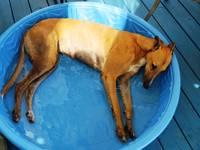
With summer weather (especially in Perth County) comes high temperatures, high humidity and the occasional heat wave. Pets are especially vulnerable to the heat and we see many cases of heat stroke in the summer months. Here are some tips for how to keep your pet safe during the summer.
Never leave your pet in a car on a hot day.
Unfortunately, year after year we are still seeing pets being kept in cars. Even with the windows opened, the interior of a car can quickly reach dangerous temperatures. On a 30 degree Celsius day, the temperature in a car with windows open can reach 40 degrees in only 10 minutes. What makes it worse is that dogs have a lot more difficulty cooling off than humans; relying only on panting and sweating through their feet. This means that dogs also heat up a lot faster than people, so what may be a comfortable temperature for you may be too hot for your dog.
If you need to run errands, leave your dog at home. If you need to make an unexpected stop, ask to bring your dog into the store with you. A lot of stores can be very understanding about this.
Avoid exercising your pet on hot or humid days.
While some dogs are good about policing their own activity levels, a lot of dogs will play until the point they overheat and suffer heat stroke. It is best to avoid exercise during hot and humid days. If you must, consider exercising them early in the morning or later in the evening when the day is cooler.
Always have cool fresh water available.
If your pet is to be left alone without supervision, make sure there is ample fresh water available. If your dog is left outside, make sure the water is kept in the shade and in a bowl that your dog cannot accidentally knock over. Consider also adding ice cubes to the water to keep it cooler for longer. If you are out exercising with your dog, always make sure to carry water with you so that your dog may drink. Pouring some water on its feet will also help keep it cool.
Avoid walking on pavement.
Pavement can get really hot and burn your dog’s feet. Consider only walking it in dirt or grassy areas. If it must walk on pavement, consider protecting its feet with something such as Invisible Boot.
Provide shade.
Ideally, pets should be kept indoors during extreme temperatures. If your dog must be kept outside, make sure to provide an area of shade. This is best accomplished with a tree, umbrella or tarp. Dog houses get very hot with lack of air flow and are not places your dog can go into to cool. Also consider having a children’s pool filled with water available to your dog so that he can use it to cool himself.
Prevent Hot Spots and Ear Infections
We commonly see hot spots and ear infections over the summer, especially in dogs with longer hair. The most likely cause of these issues is being wet for long periods of time. Therefore, the best course of action to prevent hot spots and ear infections is to make sure to dry your dog as best as possible after playing in water. Be sure to towel dry its body well. Also, always try to have some drying ear cleanser and cotton balls to clean out its ears after swimming.
Water Safety
Always supervise your dog while playing around water. When boating, make sure your dog also wears a life jacket like the rest of your family in case an accident happens. Breeds with short faces such as bull dogs, may need life jackets at all times to keep its nose above the water. As mentioned above, make sure to dry your dog thoroughly after swimming. For more tips on water safety, see our previous blog.
Boarding
If you plan on boarding your dog this summer, you need to make sure it is up to date with all its vaccinations including kennel cough. If your dog has never been boarded before, consider doing a short trial stay first so that it can get used to the place. For more tips on boarding your animal, see our previous kennel cough blog.
Certain pets are even more at risk of heat stroke and extra care should be taken to avoid the heat:
- Short-nosed dogs
- Dogs with heart issues
- Ill or elderly dogs
- Puppies
- Overweight dogs
What are signs of heat stroke?
- Excessive panting and restlessness
- Drooling large amounts from nose and mouth
- Stumbling around/unsteadiness
What should I do if my pet is having heat stroke?
- Remove them from the hot environment
- Get towels soaked with cool water (cold setting on the tap) and place around neck, in armpits, in groin area and wet feet
- Do NOT use ice packs or ice water as this will actually prevent cooling by constricting the blood vessels
- Do NOT force water into your dog’s mouth, but offer some to him if he is interested
- Bring your dog to a veterinarian while cooling him
Heat stroke can be prevented by following the above recommendations. If you ever have any concerns that your dog may be over heating, contact your veterinarian right away. We at Mitchell Veterinary Services wish all our patients a safe and fun summer!
Recommended Read – It is Getting Hot in Perth County! Here are Some Tips on Preventing Heat Stroke in Your Dog and Cat
